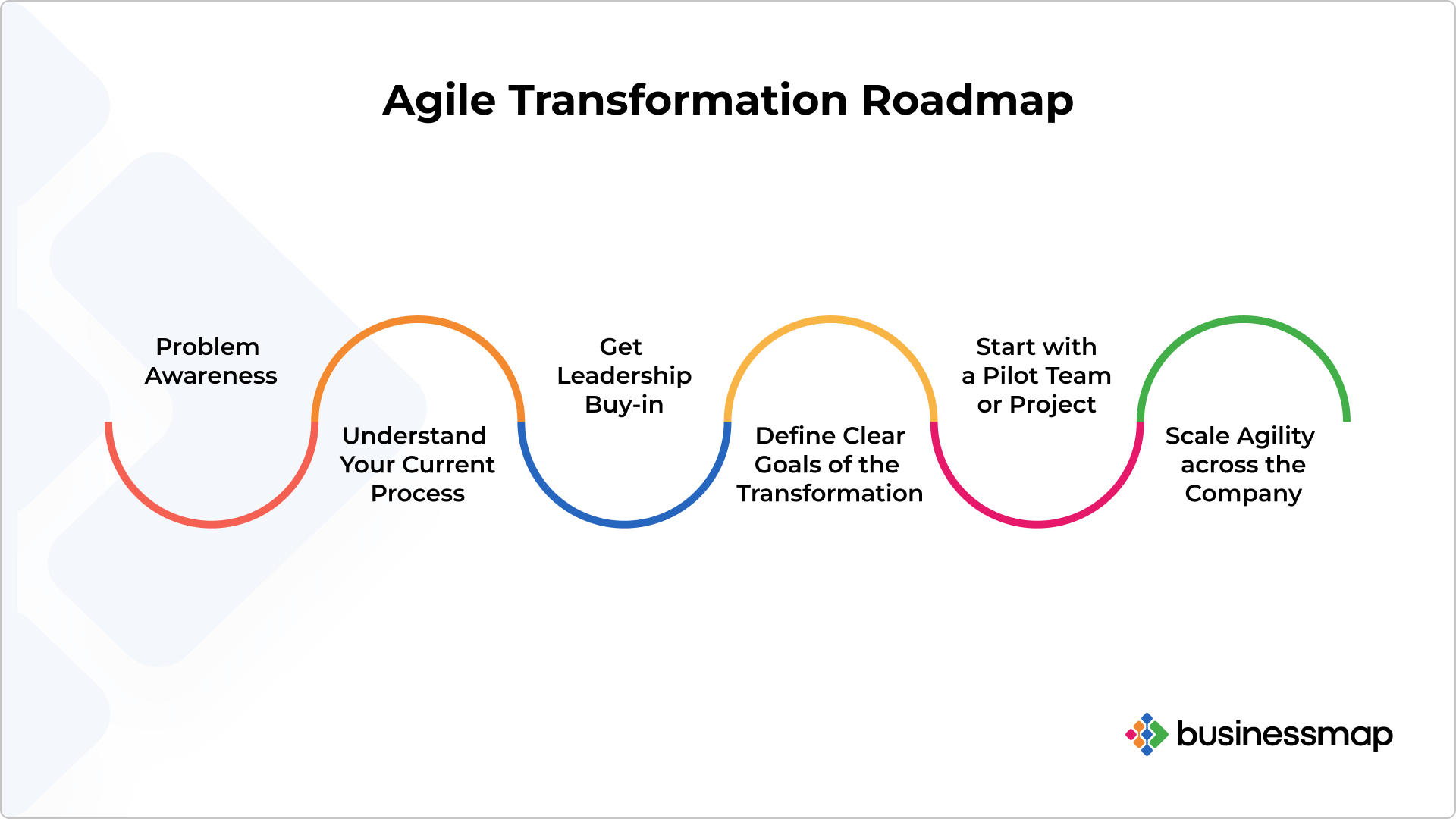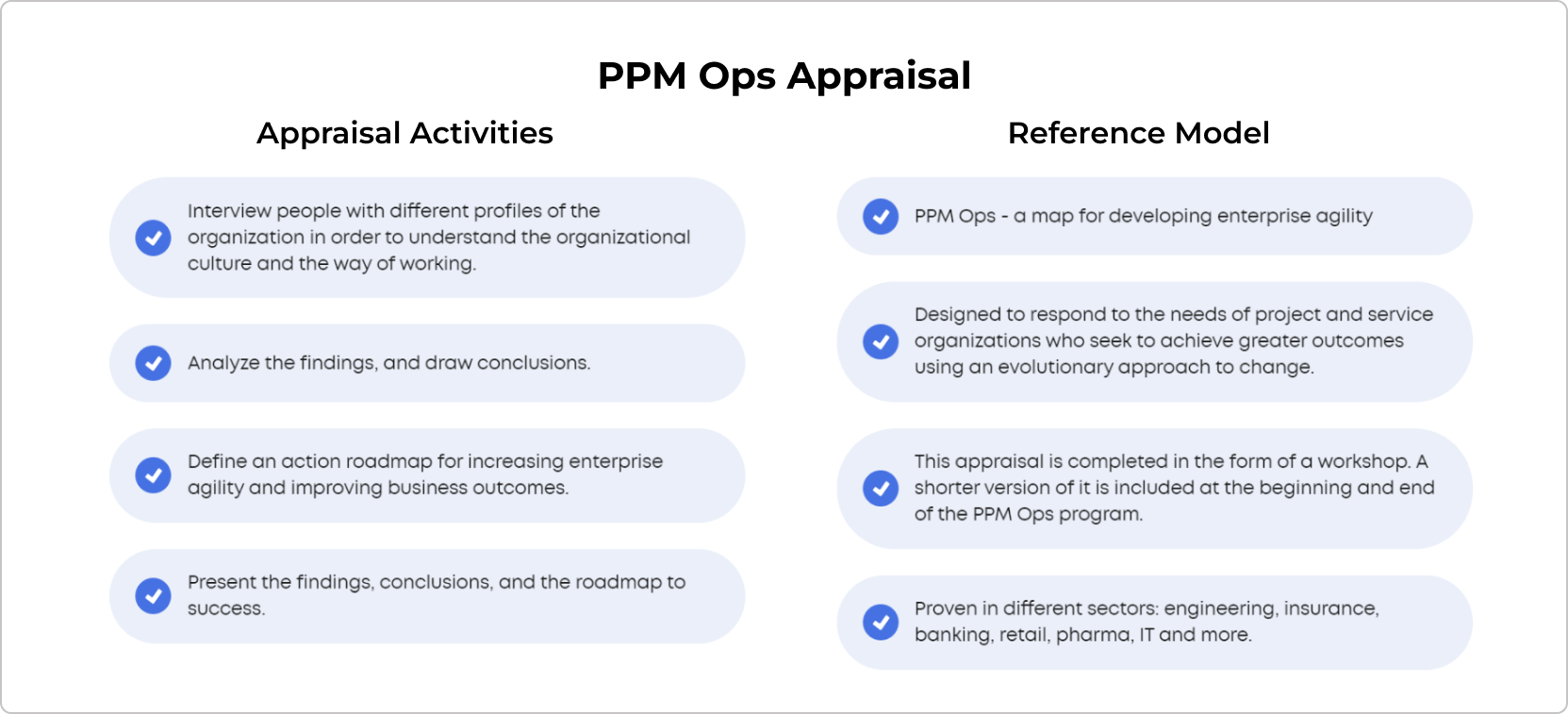Despite the growing necessity for businesses to adapt quickly to the technological turmoil and customers' demands, organizations seem to be taking a step back in terms of developing and investing in their agility capabilities. The reasons are all related to the global economic state – reducing expenses and focusing on projects that aren't as bold as taking a dive into the uncertainties of innovations.
While the above may be true according to data insights in 2023, it's clear that business agility is indicative of your organization's readiness to pivot and embrace new challenges, leveraging digital solutions to stay competitive.
Therefore, it's beneficial to assess and improve your organization's agility. Regular business agility assessments are key, as they provide insights into how effectively different competencies are contributing to overall agility. Let's explore the workings and importance of business agility assessment.
What Is a Business Agility Assessment?
Business agility assessment is a structured evaluation of various aspects of your organization to determine how well it adapts to change, delivers value, and responds to market opportunities and customer demands effectively.
The assessment helps envision the current state of the organizational capabilities and draws a plan on how to continuously develop and scale these across your organization. The goal of a business agility assessment is to create a plan informing the business domains where organizations need to invest to achieve their company goals.
Why Is Business Agility Evaluation Important?
Evaluating your business agility is crucial because it determines your capability to respond swiftly to changing market dynamics and to exploit new opportunities with ease. Without a clear assessment, you may overlook areas that need enhancement, thereby affecting your competitiveness and growth potential.
Conducting a business agility assessment provides insights into these key aspects:
-
Performance Analysis: It helps in evaluating the overall performance of the business across various functions.
-
Identifying Strengths and Weaknesses: An assessment provides a clear view of what the business is doing well and where it may be lacking, allowing for targeted improvements.
-
Strategic Planning: It forms the basis for effective and long-term strategic planning by providing data and insights into the business's current state.
-
Opportunity Identification: By analyzing market trends, customer feedback, and internal capabilities, businesses can identify new opportunities for growth, diversification, or innovation.
-
Informed Decision-Making: With a comprehensive understanding of the business, leaders can make more informed, data-driven decisions.
-
Change Management: Assessments can highlight areas in need of change and help in managing organizational changes more effectively.
-
Adaptability and Agility: In today's fast-paced business environment, regular assessments help organizations stay adaptable and agile, quickly responding to changing market demands.
Furthermore, the assessment not only identifies areas that need improvement but also helps in setting clear expectations for everyone involved in the business agility transformation initiative.
Key Domains to Assess Business Agility Maturity
Evaluating the maturity of your business agility requires examining five specific domains. These domains can provide a systematic approach to assess and guide your organization's agility and responsiveness.
Agile Practices Adoption
You can measure the adoption of Agile practices by how well Agile methodologies are integrated into your teams' daily activities. From continuous integration to regular stand-ups, the adoption of Agile practices signifies your team's progress toward efficient iterative value delivery and collaboration.
You should be able to understand how well teams collaborate across departments and functions, how self-organized people are, whether feedback is openly exchanged, and how aligned teams are to the overall company goal.
Operational Efficiency
Operational efficiency looks at the streamlined execution of your company's operations. It encompasses the tools and processes you employ to deliver value. This includes assessing the efficiency of your value streams and the effectiveness of your workflow.
At this step in the process, you should be able to understand how the flow of value delivery is measured and where the process needs improvement.
Leadership Model
Leadership focuses on how leaders in your organization empower and guide Agile teams. Effective leadership is less about command and control and more about cultivating a "learning organization" with decentralized decision-making and autonomy.
Key assessment areas include evaluating leadership's commitment to a Lean/Agile mindset, fostering a safe environment for honest feedback, or how well they inspire self-improvement.
Lean Portfolio Management
The Lean portfolio management domain concerns how your investment decisions support Agile teams and value delivery. It's about ensuring that funding models align with value delivery and that the strategic goals are understood and well communicated across the organization.
This entails ensuring there is a strong alignment between strategic portfolio management and daily operations, understanding how well value streams are coordinated, and what outcomes are used to measure progress.
Organizational Culture
Finally, organizational culture evaluates the mindset and behaviors that underscore your business's operations. A culture that embeds psychological safety, encourages risk-taking, and promotes a unified approach to challenges is critical for sustaining business agility.
What Is a Business Agility Roadmap and How Can It Be Used to Assess Business Agility?
A business agility roadmap depicts the current state of business agility maturity in your organization. It encompasses key steps and milestones that need to be achieved for your business to successfully navigate through its Agile transformation.
 A depiction of an Agile transformation process
A depiction of an Agile transformation process
When used in a business agility assessment, this roadmap serves as a benchmark to measure your organization's current capabilities against desired performance levels and can outline guidelines for achieving your goals. You'll be able to identify specific areas that require change and recognize the aspects of your operations that already align with Agile principles.
How to Assess Business Agility in 5 Steps?
Here are the five steps that are commonly included in a business agility assessment:
-
Setting Clear Goals: Define what business agility means for your organization, including the desired speed, flexibility, and customer-centricity.
-
Assessing Current State Against Benchmarks: Evaluate your existing business processes and identify how agility is currently manifested in your operations. Assess current practices against established Agile practices.
-
Performing Surveys: Collect feedback from stakeholders and teams on the Agile implementation.
-
Outlining Improvement Steps: Detail actionable plan to address gaps and enhance agility.
-
Monitoring Progress: Use the roadmap as a living document to track progress and adapt as you move forward.
By aligning your business agility roadmap with a regular agility assessment, you ensure that your strategy remains relevant, and your organization stays on the path to enhanced agility.
Who Is Involved in a Business Agility Assessment?
Various individuals and groups within an organization play crucial roles in a business agility assessment process, including:
-
Portfolio Leaders and Executives: They use the assessment as an educational tool to understand the current state of agility within the organization. It helps them align strategic objectives and champion transformation throughout the organization.
-
Transformation Agents (Change Managers, Agile Coaches): These individuals use the assessment to identify areas where agility is lacking and to develop strategies for improvement. They are responsible for drawing a map of the organization's weak spots in agility and designing targeted interventions to address these areas.
-
Managers and Team Leaders: They are involved in implementing Agile practices within their teams and departments. They use the assessment to understand how their teams can contribute to the organization's overall agility and to identify specific areas for improvement within their purview.
-
Employees: All employees are important in providing input and feedback during the assessment process. They are crucial in implementing Agile practices and contributing to the agility of the organization. Their involvement ensures that the assessment reflects a comprehensive view of the organization's agility.
What Are the Challenges Organizations Experience in Assessing Their Business Agility?
When you assess your organization's business agility, several challenges can hinder the process. The primary issues include:
Complexity of Measurement: Determining the right metrics that reflect true agility is difficult as agility encompasses various aspects of an organization, from processes to culture. Indeed, business agility measurement is reportedly one of the 10 most common challenges that organizations face. It's crucial to find balance without oversimplifying or overwhelming your assessment with too many details.
Cultural Resistance: Your employees and leaders might be resistant to change, making it hard to implement and accurately assess new Agile practices. This cultural inertia can skew your assessment of how agile your organization truly is.
Varying Definitions: Since business agility can be interpreted in different ways, aligning your team to a common understanding is essential. Without a shared definition, your assessment could lead to inconsistent results.
Keep in mind, as agility is a continuous improvement process, your assessment should be iterative and evolve over time to stay relevant.
Business Agility from Another Dimension with Businessmap
Many organizations are failing in their quest to achieve business agility in their operating models, but with the right strategy tools and guidance, it's a very achievable goal for companies of any size and complexity. We at Businessmap offer a comprehensive solution to help you enhance your enterprise agility and achieve your strategic goals.
Our specialized Project and Portfolio Management Operations (PPM Ops) solution is tailored to overcome the challenges organizations and their teams face caused by insufficient business agility. The customizable solution acts as a map, helping organizations gauge their current agility level and expand their enterprise capabilities.
The program starts with a PPM Ops Appraisal – an assessment that measures your organization's current agility and sets a target for the desired level to meet your company's objectives. The process involves meticulous evaluation of your management practices, behavior, and outcomes.
 Project portfolio management operations (PPM Ops) appraisal process by Businessmap
Project portfolio management operations (PPM Ops) appraisal process by Businessmap
The result of this assessment is a detailed, actionable plan. It highlights your organization's work performance, process consistency, and cultural strengths and weaknesses, offering a strategy to bridge gaps and enhance your agility levels.
Examples of tailored advice that might emerge from a comprehensive business agility evaluation include:
- Provide opportunities for feedback exchange, such as regular ceremonies and stand-ups, to increase the agility of operational processes across different levels.
- Facilitate tracking of delivery metrics to support decision-making based on data.
- Create more streamlined work processes to identify bottlenecks early in the value delivery process.
Businessmap is the most flexible software
to align work with company goals





 A depiction of an Agile transformation process
A depiction of an Agile transformation process Project portfolio management operations (PPM Ops) appraisal process by Businessmap
Project portfolio management operations (PPM Ops) appraisal process by Businessmap

